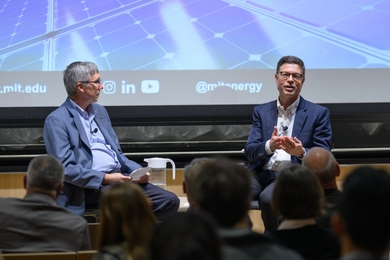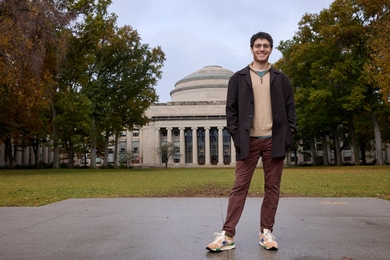A web site devoted to MIT's finances and budget planning has received a steady stream of comments and suggestions from faculty, students and staff, including offers to host information/discussion sessions.
The site at http://web.mit.edu/finances was created after President Charles M. Vest and Provost Robert A. Brown briefed the faculty on these issues at the Sept. 17 faculty meeting.
The site includes President Vest's letter to the community, frequently asked questions (FAQs) and answers, and news articles. Members of the community are invited to send in comments, questions and suggestions. Some questions already posed on the web site may be added to the FAQs.
A forthcoming section will give examples of cost-saving projects or activities that people have undertaken; descriptions of any such projects are welcome.
At the faculty meeting, Vest and Brown expressed confidence in MIT's underlying financial strength and outlined major near-term reductions in Institute spending. They described with regret the seriousness of impending cutbacks, which amount to about $70 million for fiscal year 2005, and both emphasized MIT's intellectual capital and its overall fiscal vigor.
"Our faculty has never been better. In two years, MIT has won every major award in science and engineering, including the Nobel Prize, the National Medal of Science, the Draper Prize and many others," Vest told the well-attended meeting in Room 10-250.
"Our research funding is growing. We have developed new partnerships with government and industry; we have improved stewardship of our resources, and we have sustained a major capital campaign. We have enhanced the quality of student life and have built wonderful new facilities, including Simmons Hall, the Zesiger Center and the Sidney-Pacific graduate housing," Vest said.
Brown underscored the robust status of MIT's campus research funding, which has grown annually for five years to $470 million. Vest showed a graph of The Campaign for MIT's striking upward path, and he noted enthusiastically that the capital drive is expected to reach $1.7 billion in committed funds this October.
But all these successes occur in a larger economic context. Three years of poor investment returns have taken their toll. MIT's endowment, worth $6.5 billion in 2000, dropped 17 percent in two years, to $5.4 billion in the 2001-02 fiscal year. The value of the endowment decreased again last year. As a result, the income available from the endowment to fund the operations of the Institute is expected to drop $35 million in 2004-05. That, combined with other factors such as increased costs for health care and pension benefits, has led to a significant imbalance between revenues and expenditures.
"We remain a bold institution, confident in our future. But there is an inexorable logic we have to understand. Investment returns fund a third of our operations, half of which is salaries and wages. Substantial reductions and adjustments must be made," Vest said.
Vest displayed a tri-colored bar chart, showing revenues from three sources--tuition, research, and gifts and endowments--in relation to one another and to MIT's total expenses. It illustrated graphically the Institute's increasing relative dependence on private sources of support, including gifts and investment income during this decade.
"Our goal is to make next year, 2004-05, the bottom financially and get onto a sustainable upward path thereafter. Our ability to do this will depend on teamwork, efficiency and creativity. The people of MIT, starting with our faculty, are up to the challenge," Vest said.
In his presentation to the faculty, Brown summarized MIT's current status, focusing initially on the exceptional people and achievements of MIT and on its strong competitive position, vis-Ã -vis peer institutions, in recruiting undergraduate students and in enhancing graduate research and education.
He noted that the number of postdocs and graduate students had increased steadily to approximately 7,000 in 2003, with an accompanying increase in the amount MIT spends on tuition subsidies for graduate student research and teaching assistants. At the same time, the average undergraduate scholarship has increased by $6,000 over the past five years. The number of faculty has been essentially stable, between 900 and 1,000, for the past 20 years.
The challenge for fiscal year 2005 and beyond, Brown said, will be "to maintain our competitive position for the best faculty and students." To achieve this, he said, "Our planning needs to continue to be strategic."
After Vest and Brown spoke, Erich Caulfield, president of the Graduate Student Council, expressed concern about increasing health insurance costs. The administration understands that "this is a key issue for graduate students," Brown said, indicating that a raise in stipend to help cover these costs was a possibility.
Several professors asked how the faculty could help. Among other things, Brown said, "there are ways to structure contracts and grants to help departments."
Vest also addressed the MIT community in a two-page letter dated Sept. 12. In the letter, he expressed gratitude for the "hard work, good will and teamwork" that reduced the budget by $34 million last year.
In concluding, Vest wrote:
"As we work our way through these course corrections, our decisions will reflect the mission and core values of MIT--which is an institution dedicated to the advancement of knowledge and the education of students in science, technology and other areas of scholarship that will best serve the nation and the world in the 21st century. Our stewardship of MIT during this time, as always, must support the value and uniqueness of an MIT undergraduate education, the excellence that we have achieved in graduate education and research, and the rich intellectual, racial and cultural diversity of our campus.
"Given the exceptional quality and dedication of our faculty and staff and the strong base and momentum we have achieved, I am confident that we will succeed and excel."
A version of this article appeared in MIT Tech Talk on September 24, 2003.





